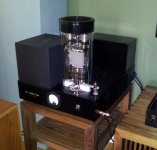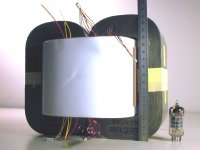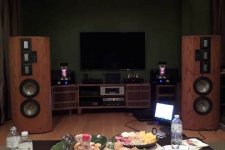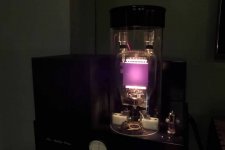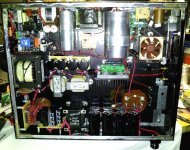I'm looking into getting some LARGE push-pull Audio Transformers wound for tubes such as the 833a power Triode. These would be at least 1000-1500 watts each into 8 ohms and for Hi-fi. The transformer company who is willing to wind them said they would use Metglass C-Cores as they are a distributor of such.
I was initially favouring Orthosil M4 E&I Lams ( which has been very positive form what I have read ), but this particular company would have to specially order them in from the USA on my behalf. Also winding audio iron for 1500 watts is not quite as straight forward as winding for 100 watts - though the principles are the same. This company has never wound audio iron this big, for power transformers - yes; but not audio; yet they know how to wind audio for smaller sized transformers. With that being so, I found the following comment in an audio paper by Menno Van der Veen which was not favourable to Metglass in audio transformers at the high frequency end of the spectrum >
4.3. Designing transformers
I can't help feeling the need to express that
designing transformers is an art. If you cure here,
you damage there. For instance, using Metglas
cures at low levels, but its overdrive behavior is
sharp nasty sounding limiting. Designing for 0.5
⋅B max makes the transformers heavy and more
expensive. Applying gaps costs money as well.
And what to say about the frequency range I did
not discuss here: environment of 20 kHz and
larger. There leakage and internal capacitances
play a leading role and then toroidal is the most
favorable shape, see
[1],[6]
.
It is not the aim of this paper to discuss all. When
only focusing on the 20 Hz to 1 kHz frequency
range, then the perm behavior is dominant. But the
transformer designer has to consider at least the
range from 20 Hz to 20 kHz and therefore shall
have to find a balance between all the goodies and
baddies of the different solutions. Fortunately, the
customer, who buys a transformer, can cure the
effect discussed by applying special valves or any
kind of feedback.
Source > http://www.mennovanderveen.nl/nl/download/download_5.pdf
So my options are > 1/.Limit the Hf end of the transformer to just BASS and use another core material for the HF end in a second or third amplifier; or 2/. Reduce flux intensity to half; or 3/. Source a different core material altogether.
I'm not ruling it out just because of this above comment.
I'm curious to know what others experiences are with Metglass.
I was initially favouring Orthosil M4 E&I Lams ( which has been very positive form what I have read ), but this particular company would have to specially order them in from the USA on my behalf. Also winding audio iron for 1500 watts is not quite as straight forward as winding for 100 watts - though the principles are the same. This company has never wound audio iron this big, for power transformers - yes; but not audio; yet they know how to wind audio for smaller sized transformers. With that being so, I found the following comment in an audio paper by Menno Van der Veen which was not favourable to Metglass in audio transformers at the high frequency end of the spectrum >
4.3. Designing transformers
I can't help feeling the need to express that
designing transformers is an art. If you cure here,
you damage there. For instance, using Metglas
cures at low levels, but its overdrive behavior is
sharp nasty sounding limiting. Designing for 0.5
⋅B max makes the transformers heavy and more
expensive. Applying gaps costs money as well.
And what to say about the frequency range I did
not discuss here: environment of 20 kHz and
larger. There leakage and internal capacitances
play a leading role and then toroidal is the most
favorable shape, see
[1],[6]
.
It is not the aim of this paper to discuss all. When
only focusing on the 20 Hz to 1 kHz frequency
range, then the perm behavior is dominant. But the
transformer designer has to consider at least the
range from 20 Hz to 20 kHz and therefore shall
have to find a balance between all the goodies and
baddies of the different solutions. Fortunately, the
customer, who buys a transformer, can cure the
effect discussed by applying special valves or any
kind of feedback.
Source > http://www.mennovanderveen.nl/nl/download/download_5.pdf
So my options are > 1/.Limit the Hf end of the transformer to just BASS and use another core material for the HF end in a second or third amplifier; or 2/. Reduce flux intensity to half; or 3/. Source a different core material altogether.
I'm not ruling it out just because of this above comment.
I'm curious to know what others experiences are with Metglass.
Very little of what I am reading from that quote makes any sense....
Nothing in that white paper is new information not already known since the 1940's and 50's, it restates the obvious and what has already been previously researched and offers no useful conclusion...
I have been designing transformers for 35 years from 10mW to 20 MegaWatt water-cooled...
METGLASS is a trade name for Amorphous cores materials....
There are quite a few types of METGLASS materials...some are more suited for audio applications than others such as the Iron Based ones as opposed to Cobalt based ones that have much lower Flux sat ... As for M4 EI laminations, these are very common and are available world-wide... as well as M3.... No need to import it from US ... Orthosil is just another trade name for CRGO Silcon Steel...These grades are suppose to follow the ASTM standards regardless of where they are manufactured..
One METGLASS to use for audio was the 2605SC...compared with the normal CRGO M6 these BH loops are very square and tend to break steeper into a sharper distortion upon over load...
The use of more exotic core materials with lower magnetostriction is great for smaller delicate SE amps with high efficiency speakers and smaller cleaner power supplies on board...
I do not see the benefits to use that material for 1500W applications and the type of speakers used in these power ranges, since this no longer Hi-Fi territory but rather more like PA system..
Your biggest problem with this type of OT is corona noise on the dielectric, which will be quite audible on large passages of music... Based on the High Voltages involved, you will need to be well insulated between Primary to Secondary wrappers... To keep the leakages at a minimum you would not want this dielectric to thick, which would lead you to high voltage synthetic tapes... MYLAR for example..ect... Winding capacitance would not be as much of an issue with Triodes as source... VPI process is not always friendly with the synthetic tapes...this is where the corona can occur and over time and break down the insulation...
Nothing in that white paper is new information not already known since the 1940's and 50's, it restates the obvious and what has already been previously researched and offers no useful conclusion...
I have been designing transformers for 35 years from 10mW to 20 MegaWatt water-cooled...
METGLASS is a trade name for Amorphous cores materials....
There are quite a few types of METGLASS materials...some are more suited for audio applications than others such as the Iron Based ones as opposed to Cobalt based ones that have much lower Flux sat ... As for M4 EI laminations, these are very common and are available world-wide... as well as M3.... No need to import it from US ... Orthosil is just another trade name for CRGO Silcon Steel...These grades are suppose to follow the ASTM standards regardless of where they are manufactured..
One METGLASS to use for audio was the 2605SC...compared with the normal CRGO M6 these BH loops are very square and tend to break steeper into a sharper distortion upon over load...
The use of more exotic core materials with lower magnetostriction is great for smaller delicate SE amps with high efficiency speakers and smaller cleaner power supplies on board...
I do not see the benefits to use that material for 1500W applications and the type of speakers used in these power ranges, since this no longer Hi-Fi territory but rather more like PA system..
Your biggest problem with this type of OT is corona noise on the dielectric, which will be quite audible on large passages of music... Based on the High Voltages involved, you will need to be well insulated between Primary to Secondary wrappers... To keep the leakages at a minimum you would not want this dielectric to thick, which would lead you to high voltage synthetic tapes... MYLAR for example..ect... Winding capacitance would not be as much of an issue with Triodes as source... VPI process is not always friendly with the synthetic tapes...this is where the corona can occur and over time and break down the insulation...
Last edited:
Just curious as to what the application is for this 833a tube ???
I assume a 0-bias Push-Pull amp ???
Keep in mind that such an amp is analogous to an H-Bomb...ie, you basically need another smaller amplifier just drive this tube.... I think of it as re-amping.... Probably be easier to drive these 833a tube grids with a Williamson amp...
I assume a 0-bias Push-Pull amp ???
Keep in mind that such an amp is analogous to an H-Bomb...ie, you basically need another smaller amplifier just drive this tube.... I think of it as re-amping.... Probably be easier to drive these 833a tube grids with a Williamson amp...
833A
Amperes of grid current, certainly not HiFi.
Even if Mosfets are used to drive the grids, that much current suddenly disappears from the plate current on zero crossings of the grid. An antique shaker table amp?
Amperes of grid current, certainly not HiFi.
Even if Mosfets are used to drive the grids, that much current suddenly disappears from the plate current on zero crossings of the grid. An antique shaker table amp?
Last edited:
Just curious as to what the application is for this 833a tube ???
I assume a 0-bias Push-Pull amp ???
Keep in mind that such an amp is analogous to an H-Bomb...ie, you basically need another smaller amplifier just drive this tube.... I think of it as re-amping.... Probably be easier to drive these 833a tube grids with a Williamson amp...
I've seen photos of them standing 4 in a row glowing beautifully through a glass window on the front of a radio station transmitter unit.
Monolith Magnetics uses the largest available Metglas Amorphous C-cores in their 833 SE OPTs, and they sound fantastic at 2.3kV plate voltage and 160mA plate current. Great bass, crystal clear highs, magical midrange. Each OPT weighs 62lbs!
First hand experience in my Midlife Crisis amps speaking.
http://www.diyaudio.com/forums/tubes-valves/232484-midlife-crisis-my-833c-amp-build.html
First hand experience in my Midlife Crisis amps speaking.
http://www.diyaudio.com/forums/tubes-valves/232484-midlife-crisis-my-833c-amp-build.html
Attachments
Last edited:
Monolith Magnetics uses the largest available Metglas Amorphous C-cores in their 833 SE OPTs, and they sound fantastic at 2.3kV plate voltage and 160mA plate current. Great bass, crystal clear highs, magical midrange. Each OPT weighs 62lbs!
First hand experience in my Midlife Crisis amps speaking.
http://www.diyaudio.com/forums/tubes-valves/232484-midlife-crisis-my-833c-amp-build.html
Do you have 2 of those?
I have though about building a push-pull 833a amplifier for maybe the last 25 years.
I have no need for one, but that has not stopped me from thinking about it.
The 833 has fairly low plate resistance and is really linear. Hard to beat for higher power push pull.
Are you planning to use this full range from 20hz hz to 20Khz?
If using only above something like 100 hz, you should be able to reduce transformer size and extend the HF range, or at least have an easier time reaching 20Khz without much negative feedback.
For driving the 833, I think I would go with an el-34 as a follower.
If you are able to bias at 0 volts, you can use a transformer on the cathodes of the followers to simplify the circuit. See the Altec 1570B for an example. If you need to have negative grid voltage, a follower with a cathode resistor to some negative voltage would work.
A 6bl7 would be a good choice for last voltage gain before the el34 followers. You should get enough swing out of a 6bl7 voltage amp. You may also get enough swing out of a 6sn7 of you are only asking for closer to 1000 watts. Again see the Altec 1570 as an example.
Low plate resistance of the 833 means your power supply needs to be fairly stable. Something like an 811 with high plate resistance does not care so much if the supply rails flap a bit. Lower plate resistance means lower PSRR.
Example amplifier would have some voltage amplifier followed by a phase splitter followed by the 6bl7 for voltage amplifier and then to the el34s.
I really think you can pull a really good sounding push pull 833 amplifier if you need that much power. I know people use the Altec 1570 for cinema sound because it just sounds good at higher power levels.
Lots of luck with this.
I have no need for one, but that has not stopped me from thinking about it.
The 833 has fairly low plate resistance and is really linear. Hard to beat for higher power push pull.
Are you planning to use this full range from 20hz hz to 20Khz?
If using only above something like 100 hz, you should be able to reduce transformer size and extend the HF range, or at least have an easier time reaching 20Khz without much negative feedback.
For driving the 833, I think I would go with an el-34 as a follower.
If you are able to bias at 0 volts, you can use a transformer on the cathodes of the followers to simplify the circuit. See the Altec 1570B for an example. If you need to have negative grid voltage, a follower with a cathode resistor to some negative voltage would work.
A 6bl7 would be a good choice for last voltage gain before the el34 followers. You should get enough swing out of a 6bl7 voltage amp. You may also get enough swing out of a 6sn7 of you are only asking for closer to 1000 watts. Again see the Altec 1570 as an example.
Low plate resistance of the 833 means your power supply needs to be fairly stable. Something like an 811 with high plate resistance does not care so much if the supply rails flap a bit. Lower plate resistance means lower PSRR.
Example amplifier would have some voltage amplifier followed by a phase splitter followed by the 6bl7 for voltage amplifier and then to the el34s.
I really think you can pull a really good sounding push pull 833 amplifier if you need that much power. I know people use the Altec 1570 for cinema sound because it just sounds good at higher power levels.
Lots of luck with this.
Just curious as to what the application is for this 833a tube ???
I assume a 0-bias Push-Pull amp ???
Keep in mind that such an amp is analogous to an H-Bomb...ie, you basically need another smaller amplifier just drive this tube.... I think of it as re-amping.... Probably be easier to drive these 833a tube grids with a Williamson amp...
No not zero bias - it's just a thing I want to do on my bucket list since I was a teen.
I have an RCA AM Modulator design which uses two cathode driven 807 tubes to drive the 833 pair with no driver transformer and another two 807 to drive those.
I think it was set up for Class AB2.
6 tubes in the whole amp, plus two gas tubes in the main power supply on about 2,600 volts. The output transformer is my main drama sourcing / making.
Do you have 2 of those?
Yes, I do. Here are some more pictures. They drive the Infinity RSIIb speakers extremely well.
First picture is of one of the OPTs under construction.
Second is of the whole system playing.
Third is a closeup of a glowing 833C.
Fourth is the underside of one amp.
Attachments
 Keep things civil and respectful guys, couple of borderline comments here. Posts removed.
Keep things civil and respectful guys, couple of borderline comments here. Posts removed.
Last edited by a moderator:
Have a look at the plate curves for an 833. Draw some load lines.
They are not just pretty on the outside.
They are not just pretty on the outside.
Have a look at the plate curves for an 833. Draw some load lines.
They are not just pretty on the outside.
Been there... I came across one of these at a run o' the mill flea market one day in a box of other assorted electronic junk. The electrodes looked like they had never been in a socket or connector. I had never seen a tube like that was fascinated so I bought it for $1 US. Took it home, researched it, checked the heater for continuity, kept it for a couple of years while I played around with the idea of creating a display and make it a 100W night light. Saw they were going for @$75 - $100 in auctions.... traded it at a ham swap meet for a Dynaco PA-060 tranny.
Magz, still have never had a chance to listen to that. Were talking about an AK meet up in Verona NJ, maybe in September. Join us.
BillWojo
BillWojo
Magz, still have never had a chance to listen to that. Were talking about an AK meet up in Verona NJ, maybe in September. Join us.
BillWojo
Verona's about 1/2 hour from me, definitely do-able. Can't bring my amps there, though, they weigh 180lbs each.
However, I would love to join up and maybe set up a tour of our systems over the next few months.
Details by pm, perhaps?
how much global feedback ( if any ) are you using to flatten the gain?
Is that question for me? Zero.
- Home
- Amplifiers
- Tubes / Valves
- Has anyone tried Metglass C-Cores in Audio Transformers ?
